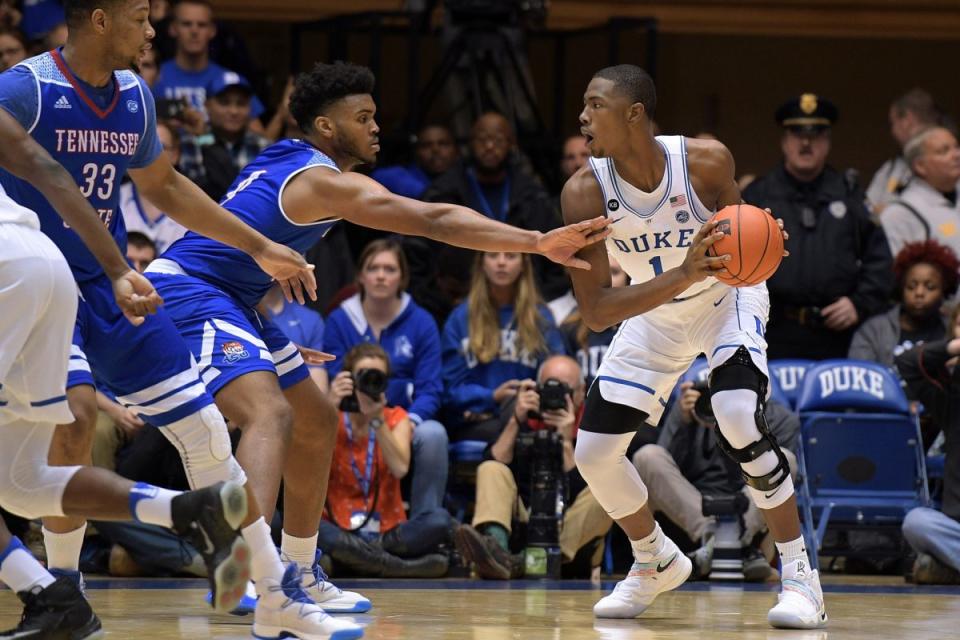Why Duke's Harry Giles was right to turn pro despite disappointing season

It’s uncommon for a bench player averaging 3.9 points and 3.8 rebounds to enter the NBA draft.
It’s even more unusual for it to clearly be the right decision.
That’s the case for Duke freshman Harry Giles, who was hailed as the No. 1 prospect in the loaded 2016 class before a series of knee injuries at least temporarily robbed him of the explosiveness he displayed in high school. Duke announced Tuesday that Giles will enter the draft and sign with an agent, ending his college eligibility.
“With his uplifting personality and love for the game, Harry Giles has been a joy to coach,” Duke coach Mike Krzyzewski said in a statement. “He is only beginning to scratch the surface of how good he can be on the basketball court. Harry has an exciting NBA future ahead of him and we are here to fully support him as a member of our brotherhood.”
Giles’ decision to turn pro instantly makes him the most hard-to-peg prospect in this year’s NBA draft. Some scouts remain impressed enough with his talent to suggest he could still be worth a mid-first-round flier. Others are concerned enough with his injury history and lack of impact in his lone season at Duke that they wouldn’t risk taking him until the early second round.
Had Giles chosen to return to Duke, there’s a chance he’d regain his former aggressiveness and bounce, tap into his immense potential and solidify himself as a 2018 lottery pick. The problem is there’s an equally good chance he’d torpedo his chances of being selected at all with another subpar season or worse yet another knee injury.
Not taking that risk was a smart move by Giles. Better to secure a guaranteed contract now while it’s still available than pin your hopes on blind faith.
That Giles had to make such a tough decision would have been almost unfathomable a few years ago. The 6-foot-10 forward drew frequent comparisons to former NBA all-star Chris Webber thanks to his ferocity on the glass and explosiveness around the rim.
The first warning sign for Giles arrived prior to his sophomore year of high school when he tore the ACL, MCL and meniscus in his left knee. He returned the following year to reclaim his status as the top prospect in the 2016 class, but his comeback was derailed in fall 2015 when he tore the ACL in his other knee and had to sit out his entire senior season of high school.
Giles had hoped to be at full strength by the start of his freshman season at Duke, but lingering pain in his right knee forced him to undergo arthroscopic surgery on Oct. 3, causing him to sit the first six weeks of the season. He made his debut off the bench on Dec. 19 against Tennessee State, a night of breathless hype but forgettable results.
Fans throughout Cameron Indoor Stadium stood, craned their necks and applauded as Giles rose from the bench and checked in with just under 12 minutes left in the first half. Even Duke’s social media czar couldn’t resist adding to the fanfare, sending out a tweet with Giles’ picture accompanied by the words, “It’s time.”
What it was time for, alas, was a reality check. This version of Giles was a shadow of his former self. He logged only four minutes, badly missing a mid-range jumper on his initial possession of the game and moving cautiously throughout the rest of his brief stint on the floor.
There were some better games ahead for Giles, most notably a 12-point, 10-rebound performance against Georgia Tech on Jan. 4 and a seven-point, six-rebound, four-block effort against North Carolina in the ACC semifinals. But Giles had many more nights where he was a non-factor, no longer quick enough to properly defend ball screens and no longer athletic or active enough to make an impact on the glass or at the rim.
In Duke’s two NCAA tournament games, Giles logged a total of 15 minutes and missed the only shot he attempted. He remained engaged on the bench and maintained a relentlessly positive attitude under difficult circumstances, but his body would not allow him to make the impact he wanted.
The question facing Giles now is this: Will he ever come close to fully regaining his explosiveness with more time or is this who he is now? The answer might not be clear for another year or two, let alone by draft day this June.
In his statement announcing his decision to turn pro, Giles said his year at Duke “has been a dream come true,” citing the many strong relationships he has built.
That positivity is admirable in the wake of a season that undoubtedly went a lot differently than he once anticipated.
More college basketball content from Yahoo Sports:
– – – – – – –
Jeff Eisenberg is the editor of The Dagger on Yahoo Sports. Have a tip? Email him at daggerblog@yahoo.com or follow him on Twitter!



